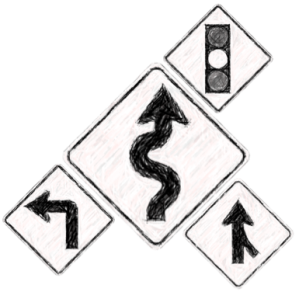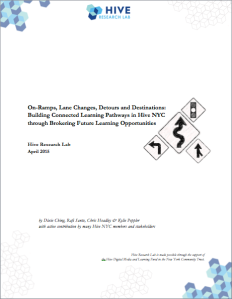In the summer of 2014, Hive Research Lab facilitated a design charrette focused on supporting youth interest-driven learning trajectories in the Hive. As part of the preparation for the meeting, m embers were asked to provide illustrative examples of what successful pathways or trajectories looked like on the ground. From the extraordinarily rich stories that members provided emerged our latest publication, a community-developed white paper entitled: On-ramps, Lane Changes, Detours and Destinations: Building Connected Learning Pathways in Hive NYC through Brokering Future Learning Opportunities.
embers were asked to provide illustrative examples of what successful pathways or trajectories looked like on the ground. From the extraordinarily rich stories that members provided emerged our latest publication, a community-developed white paper entitled: On-ramps, Lane Changes, Detours and Destinations: Building Connected Learning Pathways in Hive NYC through Brokering Future Learning Opportunities.
This paper [pdf, exec sum, handout] makes a strong case for the importance of brokering as a key strategy for supporting youths’ interests in sustained and robust ways. Brokering (1) connects youth to meaningful future learning opportunities including events, programs, internships, individuals, and institutions that will support their ongoing interest-driven learning; and (2) enriches youth social networks with adults and peers that are connected to or have knowledge of future learning opportunities. The paper emphasizes that the Hive NYC community—with its robust social network of educators and professionals—represents an impressive cache of human and social capital that could be leveraged more fully through brokering.
 Challenges to brokering are discussed as well, including how a young person’s network orientation or help-seeking orientation may affect her ability to take up and navigate the opportunities brokered by high resource individuals. Several recommendations targeted towards individual organizations and the network are offered as generative starting points for thinking about ways to extend the impact of brokering.
Challenges to brokering are discussed as well, including how a young person’s network orientation or help-seeking orientation may affect her ability to take up and navigate the opportunities brokered by high resource individuals. Several recommendations targeted towards individual organizations and the network are offered as generative starting points for thinking about ways to extend the impact of brokering.
We wish to thank the 70+ individuals (named in the Appendix) who engaged in the collaborative sensemaking discussions, reflective conversations, and feedback-giving that resulted in this paper. We hope this collective effort felt of value to all who participated and that HRL, as facilitators of the process, was able to capture adequately the thinking and expertise of the community.
And of course, we look forward to more conversations and collective knowledge building around this core youth development practice!

